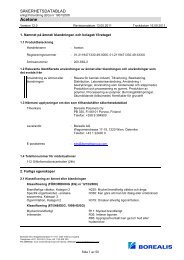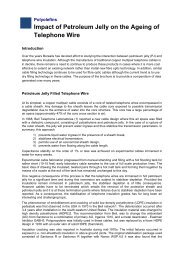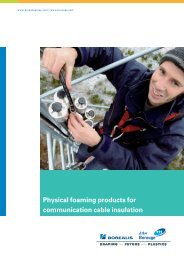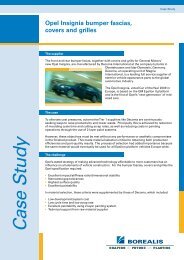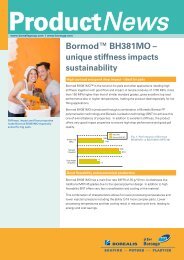Plastic waste from cables - Borealis
Plastic waste from cables - Borealis
Plastic waste from cables - Borealis
Create successful ePaper yourself
Turn your PDF publications into a flip-book with our unique Google optimized e-Paper software.
<strong>Plastic</strong> <strong>waste</strong><br />
<strong>from</strong> <strong>cables</strong><br />
Introduction<br />
As with all industrial activity, <strong>waste</strong> is generated during the<br />
manufacturing of <strong>cables</strong> and when <strong>cables</strong> are scrapped. For<br />
economical and environmental reasons recycling or recovery<br />
of the material components <strong>from</strong> this <strong>waste</strong> is essential. The<br />
need for effective recycling solutions is based on the increasing<br />
scarcity of natural resources and the need to reduce the<br />
environmental burden – including the generation of greenhouse<br />
gases.<br />
<strong>Borealis</strong> and Borouge are the world’s leading providers for<br />
innovative, value-creating plastics solutions for the wire and<br />
cable industry. Our philosophy is to provide innovative materials<br />
that allow for the problem free operation of <strong>cables</strong> over very long<br />
time spans. Long life, without the need to frequently scrap and<br />
replace <strong>cables</strong>, is an effective way to limit the environmental<br />
burden.<br />
Even so, we understand our responsibility to deal with issues<br />
related to cable <strong>waste</strong>, and have been, for many years, active in<br />
research with industry partners to further develop the recycling<br />
technology.<br />
Cable <strong>waste</strong><br />
Cable <strong>waste</strong> comes <strong>from</strong><br />
• cable production<br />
• end of the functional life of the <strong>cables</strong><br />
• scrapped <strong>cables</strong> when there is no need.<br />
The <strong>waste</strong> can comprise of a multitude of components such as<br />
metals, plastics, rubber, paper and glass fibres.<br />
Driving force for cable <strong>waste</strong> recycling<br />
The main driving force to recycle cable <strong>waste</strong> is to recover the<br />
valuable metals such as copper and aluminium.<br />
Recycling of plastic components is encouraged by authorities in<br />
Europe as disposal in landfills is not accepted. Disposal by other<br />
means are associated with costs and therefore the industry is<br />
encouraged to find new cost effective solutions for the handling<br />
of cable <strong>waste</strong>.<br />
Cable plastic <strong>waste</strong> management<br />
Waste that is generated during cable manufacturing is sorted<br />
at the source and either reprocessed or recycled for alternative<br />
applications. Waste <strong>from</strong> end of life and scrapped <strong>cables</strong> that are<br />
collected <strong>from</strong> different sources constitute a broad mix of cable<br />
types and material components. A pre-sorting of these <strong>cables</strong><br />
is made as a first step, then granulation and separation of the<br />
plastics <strong>from</strong> the metal occurs.<br />
Separation of the plastics is made by a sink / float technique<br />
where heavy plastics sink in water and lighter plastics float.<br />
A new technology that combines the sink / float techniques with<br />
a gravimetric separation allows for a further separation of metal<br />
<strong>from</strong> the light plastic making a total separation yield of 99–99.9 %<br />
metal. This means that the purity of the light plastics is high and<br />
attractive for energy recovery or recycling.
WC HO 501 GB 2012 02 BB<br />
Recycling of cable plastic <strong>waste</strong><br />
The main plastic components in cable <strong>waste</strong> <strong>from</strong> <strong>cables</strong> recycled today are PVC and<br />
polyethylene, either in crosslinked (XLPE) or thermoplastic (PE) form.<br />
The separation technique in use today enables effective separation of the two main types.<br />
The PVC fraction can be re-melted and processed to new products.<br />
As the separated components are less clean than virgin material, the recycled material is<br />
typically used in applications with lower quality requirements.<br />
XLPE <strong>from</strong> cable <strong>waste</strong> can be recycled<br />
XLPE <strong>waste</strong> is crosslinked and it cannot be reprocessed as a 100% ingredient. However, it<br />
has been shown that a mix between virgin PE and up to 60 % XLPE <strong>waste</strong> gives a mixture<br />
that can be reprocessed. This results in a material with good mechanical properties that can<br />
be used, for example, in injection moulded articles. As the market for moulded products<br />
based on recycled polyolefins represents several thousand tonnes per year in Europe, this<br />
offers many opportunities. Recycle of <strong>waste</strong> <strong>from</strong> <strong>cables</strong> in certain cable applications is also a<br />
possibility such as cable jacketing (figure 1).<br />
Another option is to recover the energy of PE and XLPE. These materials originate <strong>from</strong><br />
hydrocarbons and carry an energy capacity similar to oil. As the new technique for cable<br />
<strong>waste</strong> separation produces a very clean light fraction, it can be used in such applications as<br />
complementary fuel in district heating plants or in cement kilns.<br />
Production <strong>waste</strong><br />
XLPE/LLDPE recycled<br />
compound<br />
Figure 1: Recycling of XLPE into <strong>cables</strong><br />
Granulated XLPE<br />
Extrusion cable jacked<br />
Grounded XLPE<br />
Cable with inner-jacket of<br />
recycled compound<br />
References<br />
• „Environmental considerations for<br />
end of life disposal of <strong>cables</strong>”<br />
B. Helmesjö, B. Hagström.<br />
Jicable 2003. B.4.2 p. 421– 426<br />
• „Electrical insulation systems<br />
and assessment methodologies<br />
for energy technology and clean<br />
environment”.<br />
R.N. Hampton. Nord-IS 2005.<br />
Invited paper<br />
• „Development of recycling<br />
technology of XLPE”.<br />
Sekiguch et.al. Jicable 2007.<br />
C.5.1 p 599 – 604.<br />
• „Recycling of XLPE insulations”.<br />
A. Boss, B. Hagström.<br />
NordIS 2009<br />
• „PlastSep- A new technology<br />
for sorting and recycling of<br />
cable polymers”.<br />
E. Rasmussen,<br />
A. Boss NordIS 2009





